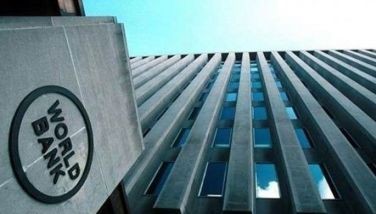GSIS says it has enough funds to retire all 1.5-M gov’t workers
October 4, 2003 | 12:00am
Under heavy fire for delays in pension payments and suspension of loans to its members, the Government Service Insurance System (GSIS) said all 1.5 million government employees could retire today and it could still fulfill its obligations if it could sell "some real estate assets and collect some of its receivables".
GSIS is under attack for anomalies in its fund management, but in a statement, the state-controlled fund said yesterday that it had cash-on-hand of P16 billion as of September, more than enough to meet its obligations.
"Even if all of its 1.5 million members retire this year, the GSIS will still be able to service all of them depending on the disposition of some of its real estate assets and also the collection of some of its receivables," said the GSIS in a release, quoting Commission on Audit director Juanito Espino Jr.
In the statement, the GSIS also recanted its earlier report that the National Government owed it a total of P22 billion, admitting that its actual receivables were only P7.2 billion as reported by the Department of Budget and Management (DBM).
"Wittingly or unwittingly, many government agencies have either underremitted or entirely failed to remit the required premium contributions to the GSIS, resulting in huge arrearages and interest charges," said GSIS president and general manager Winston Garcia.
The GSIS has been under investigation by the Department of Finance for questionable transactions, including the controversial acquisition of expensive artworks which the COA said "may be clothed in impropriety".
The 2002 audit report of the COA examined the acquisition of Juan Luna’s "Parisian Life" and two other artworks by eminent Filipino painter Fernando Amorsolo, amounting to a total of P53.352 million.
The COA report covered GSIS‚ financial and investment performance in 2002, including the controversial acquisition of Juan Luna’s Parisian Life from Christie’s auction house in Hong Kong.
In the COA report, it was revealed that the GSIS bought "Parisian Life" at Christie’s for a total of P47.036 million. In the same auction, GSIS also bought Amorsolo’s "Under The Mango Tree" for P4.632 million and his "Rice Field" for P1.684 million.
According to the COA, payments were made for the paintings from the General Insurance Fund in October 2002 and not from the Social Insurance Fund which included the contributions of members.
The COA report indicated that the paintings were later booked under "Other Assets (Paintings and Tapestries)" account of the GSIS.
"We requested management to give us information on how necessary the ‘Parisian Life’ painting is in carrying out the purposes of its mandate," COA said in the report.
According to the COA report, GSIS invoked Republic Act 8291 which allowed the fund to "invest funds of the GSIS, directly or indirectly, in accordance to the provisions of this act."
Under the law, GSIS was allowed to make investments that may further develop or renovate its assets with its own capital. COA said the GSIS argued that the purchase of Parisian Life was an exercise of its "incidental power" and the purchase was charged against power funds.
COA validated GSIS’s report that it used its general funds from earnings, profits and excess liquidity of the GIF and no deductions were made from the independent SIF which represented member contributions and their earnings.
According to COA, however, the GSIS justification was "of no moment" because the modes of investments of GSIS‚ excess funds were clearly enumerated in Section 36 of the GSIS charter.
"It should be emphasized that there is nothing in Section 36 that involves investment in artwork like Juan Luan paintings," the COA said.
GSIS is under attack for anomalies in its fund management, but in a statement, the state-controlled fund said yesterday that it had cash-on-hand of P16 billion as of September, more than enough to meet its obligations.
"Even if all of its 1.5 million members retire this year, the GSIS will still be able to service all of them depending on the disposition of some of its real estate assets and also the collection of some of its receivables," said the GSIS in a release, quoting Commission on Audit director Juanito Espino Jr.
In the statement, the GSIS also recanted its earlier report that the National Government owed it a total of P22 billion, admitting that its actual receivables were only P7.2 billion as reported by the Department of Budget and Management (DBM).
"Wittingly or unwittingly, many government agencies have either underremitted or entirely failed to remit the required premium contributions to the GSIS, resulting in huge arrearages and interest charges," said GSIS president and general manager Winston Garcia.
The GSIS has been under investigation by the Department of Finance for questionable transactions, including the controversial acquisition of expensive artworks which the COA said "may be clothed in impropriety".
The 2002 audit report of the COA examined the acquisition of Juan Luna’s "Parisian Life" and two other artworks by eminent Filipino painter Fernando Amorsolo, amounting to a total of P53.352 million.
The COA report covered GSIS‚ financial and investment performance in 2002, including the controversial acquisition of Juan Luna’s Parisian Life from Christie’s auction house in Hong Kong.
In the COA report, it was revealed that the GSIS bought "Parisian Life" at Christie’s for a total of P47.036 million. In the same auction, GSIS also bought Amorsolo’s "Under The Mango Tree" for P4.632 million and his "Rice Field" for P1.684 million.
According to the COA, payments were made for the paintings from the General Insurance Fund in October 2002 and not from the Social Insurance Fund which included the contributions of members.
The COA report indicated that the paintings were later booked under "Other Assets (Paintings and Tapestries)" account of the GSIS.
"We requested management to give us information on how necessary the ‘Parisian Life’ painting is in carrying out the purposes of its mandate," COA said in the report.
According to the COA report, GSIS invoked Republic Act 8291 which allowed the fund to "invest funds of the GSIS, directly or indirectly, in accordance to the provisions of this act."
Under the law, GSIS was allowed to make investments that may further develop or renovate its assets with its own capital. COA said the GSIS argued that the purchase of Parisian Life was an exercise of its "incidental power" and the purchase was charged against power funds.
COA validated GSIS’s report that it used its general funds from earnings, profits and excess liquidity of the GIF and no deductions were made from the independent SIF which represented member contributions and their earnings.
According to COA, however, the GSIS justification was "of no moment" because the modes of investments of GSIS‚ excess funds were clearly enumerated in Section 36 of the GSIS charter.
"It should be emphasized that there is nothing in Section 36 that involves investment in artwork like Juan Luan paintings," the COA said.
BrandSpace Articles
<
>
- Latest
- Trending
Trending
Latest























